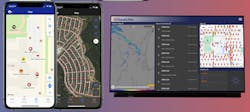There are many commonalities shared by career and volunteer departments, and by those from the city, suburbs and country. But, among the most basic and critical of these is the need to be alerted to a call. Statistics show that it only takes 30 seconds for a small flame to turn into a major fire. Blazes in grasslands can travel 14 miles per hour. And since emergency medical response now makes up the majority of runs for many departments, the fact that brain cells begin to die after about five minutes without oxygen all underscore the necessity of quick and accurate dispatch. With responses growing for many agencies these time-sensitive impacts are multiplied.
My father learned of emergencies when he heard the siren on top of the station go off. It was controlled by a switch in the homes and businesses of other members who took turns answering the emergency number. He got no information as to the type and location of the call, as a brush fire sounded the same as a request for mutual aid. A neighboring village had an air horn system, and counting the blasts let their volunteers know the closest box, but in most cases not the exact address or type. My entrance into service came during the era of home alert radios, which provided much more valuable information, but as the name suggests, alerted you only if you were at home, inside the house, and absent a power failure. These were quickly supplanted or replaced by pagers, adding the all-important aspect of portability, which was especially important for volunteers.
Monitored telegraph circuit systems have been around since before the Civil War, and remain in service today. However, their presence has dwindled, and the number of corner pull boxes has drastically been reduced due to false alarms and the cost of upkeep. Many audible alarms like the one that turned out my dad have been abandoned or are under attack due to environmental noise concerns. Given this, the need has arisen to design suitable replacements not only for today, but for the future, as well. As with seemingly everything else in our world, the digital age now rules the alerting arena. This is important because the communications networks over which alerts are generated and travel are decreasingly analog. Since response notification may generate actions across a number of different systems and devices, interoperability between multiple platforms is highly desirable.
John Martyn, senior product manager for Zetron, talked about addressing these needs. “The new fire station console is our 3rd generation fire station transponder, a digital assistant for the entire fire department sharing situational awareness of each station’s apparatus status up to dispatch and command. Each fire station’s wall-mounted large LCD touchscreen console is a mini situational awareness assistant used to track apparatus status, e.g. in quarters, responding, out of service, etc., and pushes that status up to the command level at radio dispatch as well as CAD. The CAD integration keeps the MDT informed for all to see in real time. For a complete command and control solution at the station level, we can include a PTT handset for local PA and radio needs. Fire stations have seldom had this level of integrated communications with dispatch and CAD, which results in faster response and better awareness of each apparatus in a department.”
Alerting solutions are becoming increasingly more complex, not only through interfacing with other communication and data systems, but also through controlling other functions, as well. The “smart station” concept includes zoned alerting, lighting, appliances, and bay doors reacting to the dispatch.
The company eDispatches allows dispatch information to be received in a variety of forms such as text, phone, or through their app. It also integrates several sources such as voice and CAD (computer-aided dispatch) to trigger alerts. One of their benefits is that they use firefighters’ wireless devices to deliver alarms, negating the need to carry any additional tools. Secondly, since they do not require involvement from the 9-1-1 center to operate, no procedural changes are required. Free intermediate hardware is provided that converts alerts from the dispatch center for internet supported delivery. A multi-function online dashboard allows administrators to add personnel, direct calls, and even establish do not disturb times for certain members based upon their availability.
Founded in 2004, eDispatches recently increased information available to responders by adding hydrant and places of interest to their base application. The places of interest feature can be used to identify any location selected by the local department, such as hazardous materials sites and special conditions. Hydrants may be added manually by the end users, loaded by the manufacturer, or mapped within the product while driving around town. Station reader boards are also a recent addition, and are designed to be centrally mounted sources of information. Call data, firefighter availability, response confirmation, and weather conditions are just some of the items that can be displayed.
According to Vice President Eric Troy, “eDispatches has been providing reliable service to hundreds of thousands of responders since 2004. We continue to grow our client base and innovate as technology evolves. We are excited to continue our support of emergency personnel into the future."
A slightly different approach to alerting comes from Live911, which can route the audio from incoming 9-1-1 calls to first responders prior to dispatch, potentially saving valuable time. This is accomplished by installing dedicated equipment in the apparatus or station. While initially developed for law enforcement, it could easily be configured for fire service use.
According to Jake White, communications specialist for the firm, “The calls are coming in at the PSAP (Public Safety Answering Point) and every emergency call that comes in gets livestreamed out. Administrative calls are filtered out and not sent to first responders.” In the case of multiple calls, “They're all pushed out and they show up in a table on the screen but don't all play at once. If you're listening to one, the others at the same time will be queued up and you manually click on the next.” Departments can determine how they want the audio to be routed. “It can be map driven or it can be a radius. You can set a circular distance around a fixed location or can set a geofence file that they would put in the system, so each firehouse would have a polygon that is map driven.”
Agencies are encouraged to investigate how these and other solutions integrate technically, procedurally, and operationally with their dispatch center and their end users. Insuring a quick and accurate response is a critical factor in reducing the loss of life and property, as well as promoting firefighter safety. Such decisions cannot be left to chance.

Barry Furey
BARRY FUREY, who is a Firehouse Contributing Editor, provides consulting and training services in emergency communications. He is the former director of the Raleigh-Wake Emergency Communications Center in North Carolina. During his 50-year public safety career, he has managed 9-1-1 centers and served as a volunteer fire officer in three other states. In 2005, Furey received a life membership in the Association of Public-Safety Communications Officials (APCO) International for his continued work in emergency communications. Furey was inducted into the Firehouse Hall of Fame in 2017.







